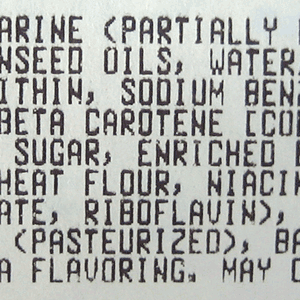 by Rachel Lincoln Sarnoff, Executive Director/CEO
by Rachel Lincoln Sarnoff, Executive Director/CEO
Healthy Child Healthy World
www.healthychild.org
Is the oil you’re sautéing with “all-natural” or is it tainted by GMOs? Is that sea bass you’re eating sustainable or has it been over-fished nearly to extinction?
Even if you read the labels, you might not know. One California consumer recently sued ConAgra for deceptive marketing by claiming Wesson oils are “100% natural” when, in fact, the products are made from genetically modified organisms, as Food Safety News reports.
The misleading “all-natural” label should surprise us, considering the Center for Food Safety estimates that 70% of processed foods on supermarket shelves contain genetically modified ingredients, defined by the World Health Organization as “organisms in which the genetic material (DNA) has been altered in a way that does not occur naturally.”
So what’s the big deal—the food still comes from natural sources, right? Yes, it does. But GMO foods most emphatically are not “natural”—even Monsanto admits that.
The problems arise when we consider the implications of GMOs in gene transfer from the food to the body—especially when those genes are antibiotic-resistant. WHO is also concerned about “outcrossing,” in which genes from GMO plants migrate into non-GMO crops, especially, I might add, when it comes to certified organic plants.
But I digress. The news this week is about food labeling, not just GMOs. And on that front, the journal Current Biology reported this month that much of the fish marketed as Marine Stewardship Council-certified Chilean sea bass was actually non-MSC certified Patagonian toothfish. Yuck.
Better labeling news comes to us from Washington state, where a new law went into effect this week that forces manufacturers of toys, cosmetics, jewelry and baby products to report to the state if their products contain hazardous chemicals such as formaldehyde, bisphenol A and phthalates, according to the Associated Press.
P.S. On the BPA front, California is well on its way to passing a law banning the substance from baby bottles, sippy cups, infant formula and baby food. Thanks, KPCC, for calling out Healthy Child Healthy World in your article!
I believe that better labeling news is on the horizon as companies move in the direction of full disclosure in anticipation of tougher regulations. Good Guide is jumping the gun to help consumers access this information with the recent launch of their Transparency Toolbar, which helps consumers search ingredients based on what’s important to them. (Full disclosure: I’m on their Mom Council.)
Finally, as Jacquelyn Ottman reports in MediaPost, the future of labeling may be less about “natural” and more about “consumer-useful” information, such as savings. Her best example? The EPA Fuel Economy label. “In terms of consumer relevance, the EPA Fuel Economy label sets the bar for a future of eco-labels that motivate rather than simply educate,” Ottman writes. “Yes, this EPA label can be applauded for its highly thorough information on greenhouse gas and smog ratings, but its real value lies in its ability to show consumers at the point of sale how much money they can save by buying a greener car.”
Saving money and saving the planet—that’s a label we’ll all read. Join the movement at HealthyChild.org!
I cant wait for the day when all labels are on the items letting consumers know the exact ingredients in the foods on the shelves, then watch the sales of those toxic items drop. Then watch those corporations make healthier organic foods because of dropped sales, then watch the organic food prices drop because all of the big companies will be fighting to get the consumers to buy their items!
Then We Win!
But theres more, we need to also force the restaurants to label on the menus as well!